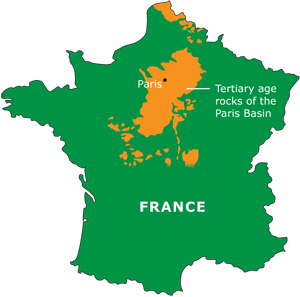
The Cenozoic Era
The Cenozoic Era is the most recent of the three major subdivisions of animal history. The other two are the Mesozoic and Paleozoic Eras. The Cenozoic spans only about 65 million years, from the end of the Cretaceous Period and the extinction of non-avian dinosaurs to the present. The Cenozoic is sometimes called the Age of Mammals, because the largest land animals have been mammals during that time. This is a misnomer for several reasons. First, the history of mammals began long before the Cenozoic began. Second, the diversity of life during the Cenozoic is far wider than mammals. The Cenozoic could have been called the "Age of Flowering Plants" or the "Age of Insects" or the "Age of Teleost Fish" or the "Age of Birds" just as accurately.
The Cenozoic (65.5 million years ago to present) is divided into three periods: the Paleogene (65.5 to 23.03 million years ago), Neogene (23.03 to 2.6 million years ago) and the Quaternary (2.6 million years ago to present). Paleogene and Neogene are relatively new terms that now replace the deprecated term, Tertiary. The Paleogene is subdivided into three epochs: the Paleocene (65.5 to 55.8 million years ago), the Eocene (55.8 to 33.9 million years ago), and the Oligocene (33.9 to 23.03 million years ago). The Neogene is subdivided into two epochs: the Miocene (23.03 to 5.332 million years ago) and Pliocene (5.332 to 2.588 million years ago).*
Stratigraphy
The concepts of Tertiary and Quaternary have an interesting history. In the 1760s and 1770s a geologist named Giovanni Arduino was studying the rocks and minerals in Tuscany. He classified mountains according to the type of rocks that he found in them. Unfossiliferous schists, granites, and basalts (all volcanic rocks) that formed the cores of large mountains he called Primitive. Fossil-rich rocks of limestone and clay that were found on the flanks of mountains over the Primitive rocks were called Secondary. Finally, there were another group of fossiliferous rocks of limestones and sandstones lying over the Secondary rocks and forming the foothills of the mountains that Anduino called Tertiary. So at first, Tertiary referred to a certain type of rock found in the area of Tuscany. But later, geologists used the fossils found in the Tertiary rocks there to recognize rocks of the same age elsewhere. Rocks with the same species of fossils were the same age.
 |
These subdivisions of the Tertiary have been correlated around the world using the fossil species in them. Rocks with the same species as Lyell's Eocene, are considered to be the same age as those in the Paris Basin. The same goes for the other subdivisions. Some time later it was noted that in areas other than the Paris Basin, there were rocks that seemed to be from time periods that were not represented in Lyell's sequence. This was because during those periods there had been no deposition in what would later be the Paris Basin. These two periods, later designated Oligocene and Paleocene, were inserted into the Tertiary in their proper places.
Cenozoic fossil localities
Bodjong Formation, Indonesia: Numerous deep-water molluscs from this Pliocene locality have given us a picture of past tropical marine life in what is today a very species rich area.
Creede Formation: A rich plant community from this Oligocene locality in southwestern Colorado includes pine, fir, barberry, and a variety of other species, all very well preserved.
Florissant Formation: This Eocene locality lies in the Rocky Mountains of Colorado. Few U.S. localities have such remarkable preservation of fossil insects.
Green River Formation: Rich in fossils of plants, insects, and fish, this Eocene locality extends across Utah, Colorado, and Wyoming in the western U.S.
Rancho La Brea Tar Pits: One of the most famous fossil localities of all, La Brea is an asphalt seep containing Pleistocene fossils located in Los Angeles, California.
Monterey Formation: Vast area of exposed Miocene outcrops along the coastal ranges of California. Fossils include macroalgae, microfossils, shells, crabs, and porpoises.
Villavieja Formation, Colombia: Until recently, our only good source of information about Tertiary animals in the South American tropics was this site in Colombia. Many of the pre-Pliocene animal groups represented have been found nowhere else outside of the continent.
Resources
* Dates from the International Commission on Stratigraphy's International Stratigraphic Chart, 2008.
David Polly, Rob Guralnick, and Allen Collins all worked on the earliest versions of this page; Brian Speer made revisions and broke the single page into several pages, 3/6/1997; Sarah Rieboldt updated the pages to reflect the Geological Society of America (GSA) 1999 Geologic Timescale, 11/2002; Dave Smith recombined the content into a single page, adapted it to the new site format, corrected dates and made minor edits, 6/2011